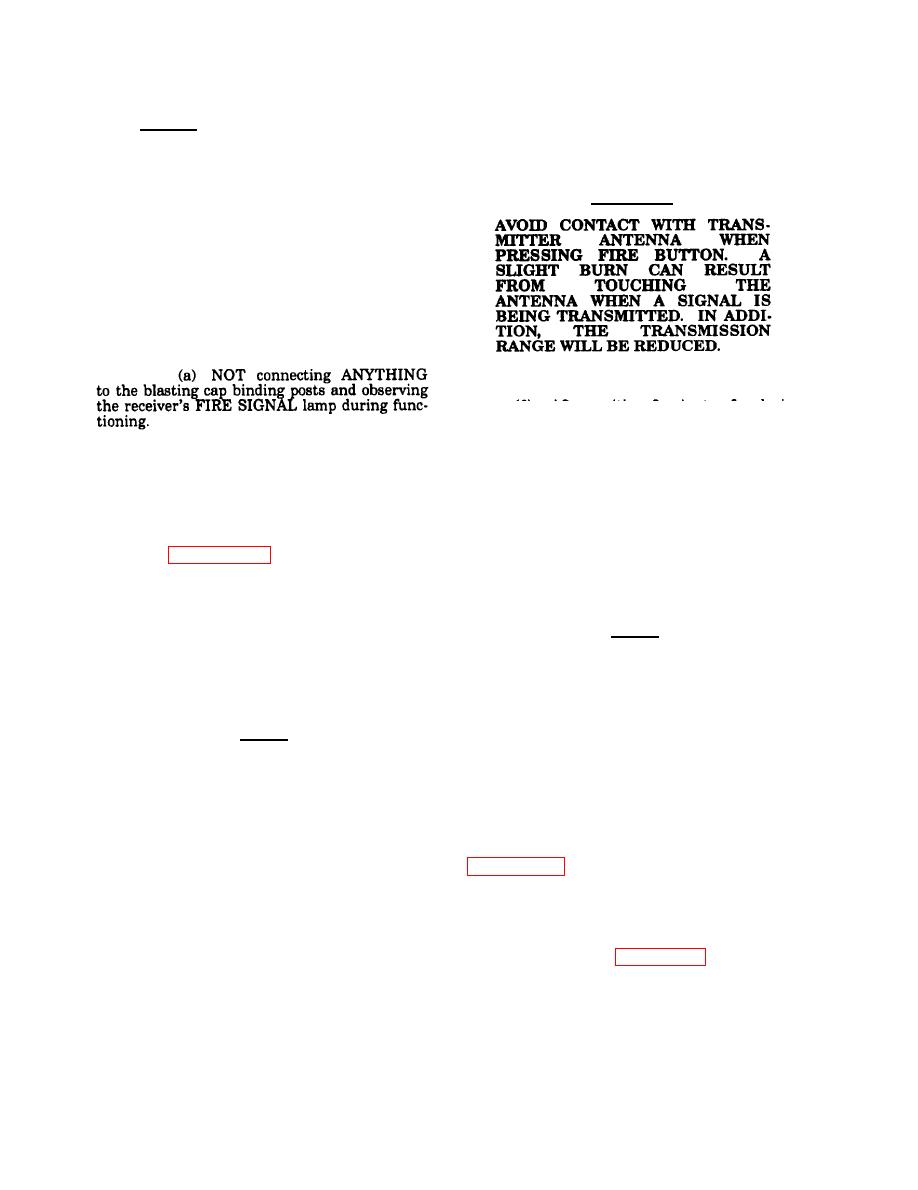 |
|||
|
|
|||
|
|
|||
| ||||||||||
|
|
 TM 9-1375-213-12-3
TO 11A20-15-1
(5) Hold receiver steady lift and move
d. Receiver. Assure. that receiver's arming
arming switch to ARM position.
switch is m SAFE position and the batterycap
is securely tightened down. Test receiver as fol-
lows:
WARNING
(1) Obtain a 10-foot length of insulated
wire. Strip an inch of insulation from one end.
Insert and secure the stripped end into receiv-
er's antenna binding post.
(2) Place receiver on ground or table"
and extend antenna vertically, securing it in
that attitude (e.g. tape the top to a tree branch).
(3) The operation of the receiver may
be checked by either of the following methods:
(6) After waiting 8 minutes for device
to arm, unscrew antenna cap and fully extend
the antenna (fig, 2-1). With the transmitter at
least 6 feet away from the receiver, lift the
(b) Connecting a blasting cap to
the blasting cap binding posts. Set the cap
FIRE button protective cover and depress the
itself safely away from receiver (for example,
FIRE button for at least 5 seconds. Observe
under a sandbag) and personnel. The cap will
the FIRE SIGNAL lamp on the receiver (or
blasting cap from a safe distance).
function if the device is working properly . The
receiver's FIRE SIGNAL lamp may NOT work
if a cap is connected to the receiver, Use the pro-
(7) Lighting of the receiver's FIRE
SIGNAL lamp (or firing of the cap) indicates
cedures in paragraph 2-3 to set up the cap prior
receiver is in working order.
to functioning.
(c) Use of a flash bulb or low volt-
age light bulb (such as a #313, 28 volt panel
bulb) across blasting cap binding posts as in (b)
NOTE
above is an acceptable alternate method of
After receiver is functioned (with or
checkout and a safer practice since no explo-
without a cap), it requires 2 to 4 min-
sives are involved.
utes to recharge before it can be func-
tioned again. Always allow the full 4
minutes in cold temperatures.
NOTE
The flash bulb (or single blasting cap)
just checks the basic operation of the
(8) If FIRE SIGNAL lamp does not
receiver, not its capacity. The capacity
light or the cap does not function, it is probably
the result of a weak battery, loose battery cap,
of the receiver can only be checked by
or corroded battery contacts.
Set arming
actually firing the rated number of cape
or setting up and using an electrical
switch to SAFE and disconnect wires. If used,
short cap wires by twisting wires together. See
test rig (which cannot be done at user
level). As a quick check, the flash bulb
rective maintenance. After maintenance or
(or single cap) is quite acceptable. If
there is any doubt about the receiver's
replacing the battery, go to step (1) above.
capacity, a full load of caps should be
used for a complete test.
(9) If a receiver is found defective and
the maintenance does not restore the unit to
serviceable condition, see paragraph 2-6 for dis-
position.
(4) Use a transmitter that has been self-
tested and determined to be in workinq order.
(10) If receiver checked out properly set
arming switch to SAFE and disconnect wire(s).
Set area code and numbers on transmitter to
Recover antenna wire for use with the same
the letter and number settings indicated on the
receiver or other receivers.
receiver to be tested (fig. 1-4). Settings are
stamped into receiver body adjacent to identifica-
tion plate.
3-10
|
|
Privacy Statement - Press Release - Copyright Information. - Contact Us |